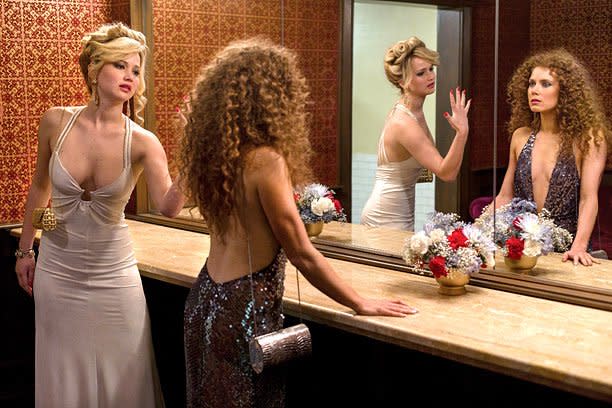Michael Wilkinson on American Hustle and Batman vs Superman costumes
Much has been written about Michael Wilkinson’s Academy Award-nominated American Hustle wardrobe, but the praise isn’t lost on the costume designer.
“This film has been a tremendously exciting journey for me,” Wilkinson — whose past credits include Man of Steel, 300, Watchmen, and The Twilight Saga: Breaking Dawn – Parts 1 & 2 — told EW. “The most surprising thing for me is that people seem to have had a personal reaction to the film. They really love the clothes… There’s talk of a reemergence of 70’s styling in the way people are dressing themselves. I’m thrilled the exuberance and the self-expression of the 1970’s is resonating with people today. People seem to want to translate it into their own wardrobes and that was something we absolutely weren’t thinking about when we made the film.”
The Oscar, BAFTA, Critics Choice, and Costume Designers Guild Award nominee is already hard at work re-imagining some of the iconic superhero costumes for director Zach Synder’s highly anticipated Batman vs. Superman, set for release in May 2016. “It’s incredibly thrilling,” he said of the experience. “I love going to work every day. We’re so excited about creating the next Batman and Wonder Woman for the 21st century. It’s great to think about making these characters relevant and really resonate with audiences today. It’s such a thrill to be working with our director Zack Snyder. He’s creating such an exciting universe for this film. I think it’s something we’re all going to be really proud of.”
Read to find out where the American Hustle wardrobe is now, which actress wore a stained dress on-screen, Wilkinson’s favorite stores for vintage shopping, and a few hints about the Batman vs. Superman costumes.
ENTERTAINMENT WEEKLY: Congratulations on your Oscar nomination! How does it feel?
Michael Wilkinson: It’s hard to put it into words. It’s humbling for your work to be recognized by your esteemed peers in the Academy. It’s gratifying to represent a lot of years of hard work on different projects. To be recognized for this film is something I’m incredibly proud of.
What are you going to wear to the Oscars?
Oh boy! Gucci has very generously offered to help dress me for this award season, so I’m looking forward to my appointment next week at Gucci. It’s interesting for me because I’m used to being “Mr. Behind-the-Scenes.” I like to have my work and my creative output in the limelight, but it’s fun for me to put myself out there and to dress myself rather than dress other people.
Where are the American Hustle costumes now?
The principal costumes are all stored in a remote archive in North Hollywood. They’re stored for various exhibition ideas and for display purposes. It’s in an archive for the film company. I’ve been reaching around there recently for various displays that are coming up. We have costumes that are going to be used in the FIDM exhibition that opens very soon. We have a couple displays in various venues and theaters across America and in Canada. I’ve just been asked to include Jennifer Lawrence’s white gown in the Hollywood Costume exhibition that Deborah Nadoolman Landis is putting together. It premiered at the Victoria & Albert Museum in London. Every now and again, she updates it with new, important clothes from films. So Jennifer Lawrence’s dress is going to join the exhibition. We created so many of these pieces from scratch for this film. I designed them for different characters and scenarios, so we have quite a big bunch now of very specific clothes that were created for the film, so we want to make sure we take care of them and give them a good future.

One of the pieces is currently featured in Diane Von Furstenberg’s “Journey of a Dress” exhibit in Los Angeles.
There’s a funny story behind that… the [dress] that made its way into the LACMA exhibition was one that we found from a dealer in Illinois. She sent us a dress. It was perfect. We did alterations and it looked strong and compelling on Amy. It was perfect for the scene, but we realized, when we were looking at the fitting photos, there was a small stain on the skirt. So, we had our people in the costume department try to mask the stain. We did our best. In the film, you don’t notice it much at all. It’s interesting — when we passed it over to LACMA for the exhibition I think they tried to remove it themselves and I think it just got worse and worse as it often happens with stains. In the end, I think they just threw up their hands and displayed it. I think Diane loved the idea that it actually kind of gave it authenticity. It was a piece that had been used and it had its own little history to it and an anecdote. At the end of the day, I think it worked within the world of David O. Russell’s films. They’re not about people who are immaculate and perfect. Life is messy. People are messy. It wasn’t about pristine, fastidious dressing. It was about having a stain on a cuff or having a shirt that was un-ironed. These people are real.
Amy’s character probably would wear a stained dress just because it had a designer label.
Absolutely. Especially with the backstory of how her character began to [access designer clothing]. She meets this guy. He shows her the dry-cleaning store where all of these great designer clothes are left and abandoned by people. She starts to incorporate them into her wardrobe. It kind of makes sense that it was a stain that wouldn’t come out and that no one bothered to come pick it up. It adds a history and backstory to it.
Where did you find the other vintage pieces?
We searched high and low to find costumes that were absolutely right for our characters. We knew we didn’t want to choose any clichés or any obvious, easy choices. We wanted to find idiosyncratic, quirky pieces that matched the quirky flare of our characters. So we looked across the country for the right pieces. We looked at rental houses and specific vintage rental collectors and dealers. We looked online and did a lot of searching. I went to flea markets and smaller boutiques. We looked through racks of amazing treasures and got all of the pieces together. With the DVF wraps, we came across quite a few in our research [of the era]. Some of them came from rental houses, some from collectors. I bought some of them from some of the great vintage boutiques out here.
Can you name a few of your favorite vintage shops?
Lots of the stuff is always [from] The Way We Wore on La Brea. It’s amazing. Doris Raymond is a national treasure. She has so much fantastic knowledge of all these things. She has incredible sources. There’s nowhere else in town you can go. She unwraps tissue paper and there’s multiple sets of unworn Christian Dior lingerie from the 1970’s. She has all of these incredible treasures. We did a lot of business with her. It was a wonderful collaboration. Of course, Decades vintage also has astonishing clothes. Then I went to NY a lot and worked a lot with certain collectors over there. In particular, there’s a woman [named] Marlene Wetherell. She has a store in Chelsea and she had some incredible pieces for us that made their way onto the big screen.

What’s the biggest misconception about your job?
Costume design isn’t just about designing pretty dresses with lots of sparkles. It’s not about making people look like they’re at their most beautiful. It’s about this intense exploration of characters. I think that’s what makes David O. Russell’s movies so compelling. It’s not just about how perfect and how fantastic life is. It’s the roller coaster of life. These characters are searching for life and humanity, but their flaws and passions are huge. I wanted to reflect that with the clothes.
Yet, it must be tough to make any one of them looked flawed. They all look like models at the end of the day.
It was amazing dressing two of the most beautiful women on the planet, but to their credit–they really enjoyed exploring these characters very deeply and checked their egos at the door. They were fearless and brave in how they threw themselves into these characters. It wasn’t about, “What makes me look at my very best?” For example, with Amy and her plunging necklines, she got into such great shape for the film and she comes across in such a strong way, but we also liked that these provocative clothes also showed a little bit of vulnerability. When you’re dressed in such an extreme, eye-catching way, you’re putting yourself out on a limb. There’s not a lot between you and the world when you’re only wearing a single layer of chiffon as a blouse or a very slinky, sheer evening dress. It’s dangerous and extreme.
How did the each character’s aesthetic give us insight into who they are?
As soon as I read the script, I realized each of the characters had a fascinating relationship with their clothes. It wasn’t like a normal script. They were really using their clothes as part of their fight for survival and as part of their constant reinvention of themselves as part of their hustle. They’re each doing it in an interesting way. With Amy Adams, she’s come to New York to reinvent herself. She wants to come across as a sophisticated woman from England, possibly royalty. Her references are magazines. She has no first hand concept of what those clothes would look like. She chooses things that have dramatic, eye-catching lines, the cleavage is low. For her, that’s sophisticated and confident. She gravitates towards designers like Halston, Gucci, Yves Saint Laurent, and Christian Dior. She puts these pieces together in her own way. It’s not runway, but it’s her own version of the woman she wants to be. Jennifer Lawrence’s character is quite different. She’s a manipulative, bored, housewife from Long Island who doesn’t want to leave the home. She’s been hiding in her clothes. Jennifer and I liked the idea that she wasn’t quite getting it right. She doesn’t really know how to dress herself properly or she’s perhaps given up. She’s quite quirky. She shuffles around the house in plush, velour sweatsuits and slippers and big, voluminous muumuus. She has a more suburban approach, but when she goes out at nighttime — it’s almost like a schizophrenia switch. She’s dressing to kill and dressing for attention to make her husband jealous. She has eye-catching eveningwear–like the leopard print, chiffon halter neck jump suit that I designed for her. And the metallic white jersey dress with the rhinestone straps at the back. She liked the idea it should be too small for her, that the lines were dangerous and provocative. She was definitely a woman out-on-the-town and looking for attention, but not necessarily pulling it off in the most sophisticated way.
How involved was David O. Russell? What direction did he give you?
He’s incredible. I don’t think there’s any other director who works quite as detailed and as passionately as he does. When he creates these characters, they’re all fully fleshed human beings to him. They’re not just concepts on a page. He knows how they talk, what food they eat, how they dance, how they walk, what sheets they have on their bed. It’s all about the details. He had strong instincts about the direction to go for each of the characters and then I supplemented that with my research… He’s extremely collaborative and likes big, bold ideas.
What can we expect from those Batman vs. Superman costumes? Will you stay true to the original designs for Batman, Superman, and Wonder Woman?
I’m not really at liberty to talk about the details of everything, but suffice to say we really respect the histories of all of these characters. We’re all very reverent about the iconic graphic nature of these characters and their costumes. We see ourselves as part of the natural lineage of how these characters are being portrayed through out the ages and our goal is to create something relevant and exciting for today’s audiences and something that works for this thrilling cinematic universe that our director Zack Snyder is creating.
What kind of research are you doing? What’s the process like when you’re designing something so iconic?
You really dive into the source material. We’re looking at all of the different ways these characters have been portrayed over the ages. We’re looking hard into Zack’s script and working out what makes sense as far as telling the story — who these people really are and what they represent, how to make sense of them in today’s world. It’s an interesting, multilayered design challenge.
When do you think the public might get their first peek at the costumes?
Ooh! Our film just got pushed. It’s now not being released until June or July 2016. I don’t know. We’re been having some interesting camera tests and photo shoots so far. I’m not exactly sure what dates we’re going to get them released, but I’m sure Warner Bros. has it all worked out.


